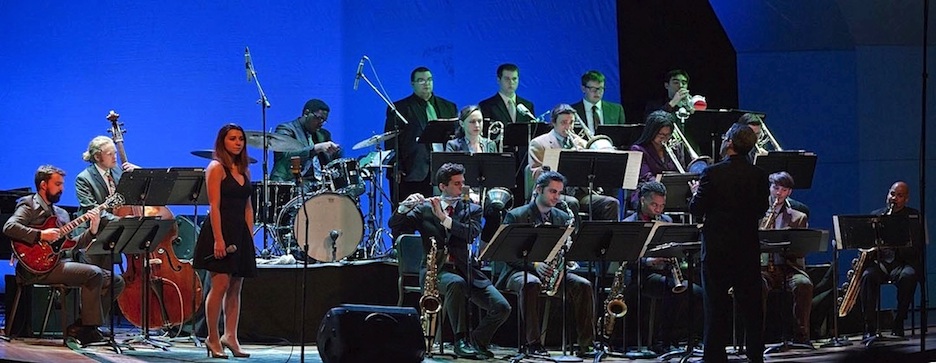 |
The Virginia Commonwealth University Jazz Orchestra I, performing under the direction of Antonio García, Director of Jazz Studies. |
This article was published as García, Antonio J. “Optimizing Jazz Ensemble Auditions for Success.” Jazz Education in Research and Practice, vol. 2, no. 1, 2021, pp. 186–193. JSTOR. The Author may post a preprint version of the Contribution on personal websites and in-home institutional repositories (IR). A preprint is the version of the article that is sent to a journal editor after review and revision but before copy editing. Therefore the preprint version shown here is a “working paper.” No part of it may be reproduced, stored in a retrieval system, transmitted, or distributed in any form, by any means, electronic, mechanical, photographic, or otherwise, without the prior permission of Indiana University Press. For education reuse, please contact the Copyright Clearance Center. For all other permissions, contact IU Press. |
Optimizing Jazz Ensemble Auditions for Success
by Antonio J. García
ABSTRACT Keywords: auditions, data, sightread, assessment |
 |
The Virginia Commonwealth University Jazz Orchestra I, performing under the direction of Antonio García, Director of Jazz Studies. |
In the first week of a new teaching position, I might hear 50-100 auditions by students I’ve never met before but need to remember individually, specifically, and from whom I had collected logistical details. Some educators can mentally sort all such data without the need for much notation. I am not such a person: I require clear notes.
Whether auditioning students in sections or as individuals, whether “blind” (behind screen) or visibly, it can be a challenge. Here’s my system.
Audition Materials
I post online the audition dates/times/locale, a menu of sample
tune-titles and styles to consider, and an annotated, MIDI-demoed rhythm sheet
(no lead sheets, due to copyrights). Our auditions call for a prepared piece,
improvisation, and sightreading in a variety of styles (swing feel required).
Choose sightreading music far in advance. I prepare the following excerpts in triplicate (one for the auditionee and two for potential adjudicators), with thick brackets marked around the targeted excerpt:
I give the student the excerpt, demonstrate the tempo sought, and invite the student to study it for 30 seconds silently. Then I count it off at an appropriate tempo—unless s/he’s a guitarist (often arriving from a more aural tradition), whom I often ask to play one pitch at a time, out of tempo. If s/he does well, I can follow by inviting a slow tempo.
Once you’ve created a packet of sightreading music that works for you, clip it together and label it with the semester and year used. Five years from now you can reuse today’s packet, followed by your second-oldest packet the next year. You may never need to select new sightreading music again.
Audition Grid Sheets
I created a system for managing audition information: within this web-presentation are freely downloadable files of that
system in both PDF and editable Word—more files delivered to you here than displayed within the print version of this article. The files <Horn Audition Grid Ferpa> and <RS
Audition Grid Ferpa> show in each block what I need to know about
that single student’s audition. I still prefer paper-entry for this data rather
than a Google form or the like. Let’s examine the Horn grid’s Sax block first:
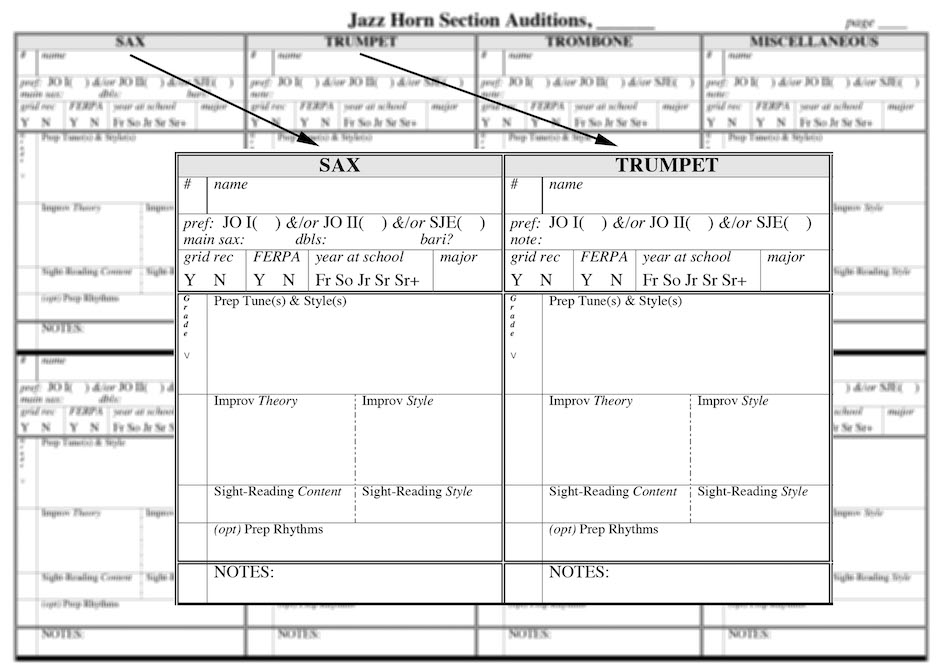 |
The form is identical for brass as for saxes, excepting the replacement of the “main sax/dbls/bari” line with a simple “note” line. The “Miscellaneous” instrument column covers any flutes, violins, bassoons, voice, or other instruments. However, the form for rhythm section is different:
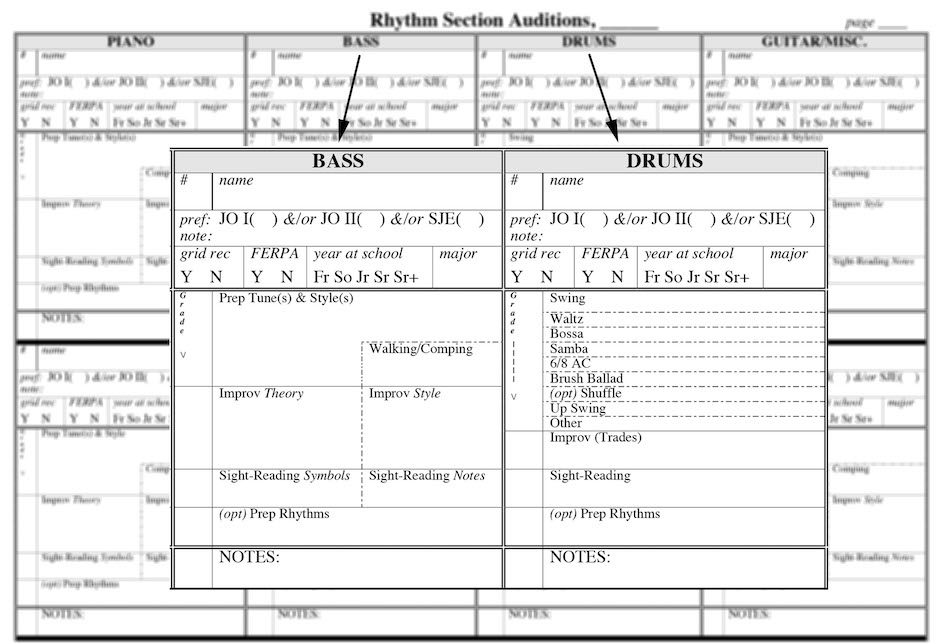 |
I typically schedule 15-minute drum slots, 10-minute slots for all other instruments. Alternatively, I schedule all 10-minute slots, including a “break” every hour that allows me to catch up with the lag created by intermittent drum auditions.
Summarizing all of this information into a 2.5” x 4” block creates an easy visual comparison with the data on other students, but one could certainly choose to store it on a full page with plenty of room for larger handwriting. (Simply enlarge the fonts and borders within one or two blocks of the provided Word files; then delete the unneeded blocks.) With this system, I can also share with any given student at a later date my constructive notes.
Adjudication Summary Sheets, Schedule
Availability
The files freely downloadable (redundant link here) from my web site in PDF and
Word demonstrate how I organize the audition information into a wider
perspective so as to create the ensembles. An overlap of available faculty and
rooms is critical.
 |
If your ensembles are not at a pre-set time and place with a selected teacher, it can be harder to align students, experience-levels, rooms, and teachers. After 25 years of figuring out this matrix on paper during all-night sessions, I now have software I created with VCU’s Computer Science Department that I call “TBA” (to be announced): it automates about 80% of the task but unfortunately is not available to the public. As a web-bonus, I'm providing you with my 2007-2010 Flow-Chart for the Proposed Software Program Titled “TBA”: perhaps you can create and market software of your own and thus make the process easier for all of us!
Suggestions
Lessons I’ve learned over the years include the following:
Announcement
If you administer a range of contrasting ensembles, you may need a
summary such as the file <Ens Results Spring> (downloadable above), noting section
leaders, rehearsal rooms, which students are authorized to pick up school
instruments from which staff member, and which faculty members teach which
sections. Getting students to register for the proper course number is one of
the biggest challenges of our process!
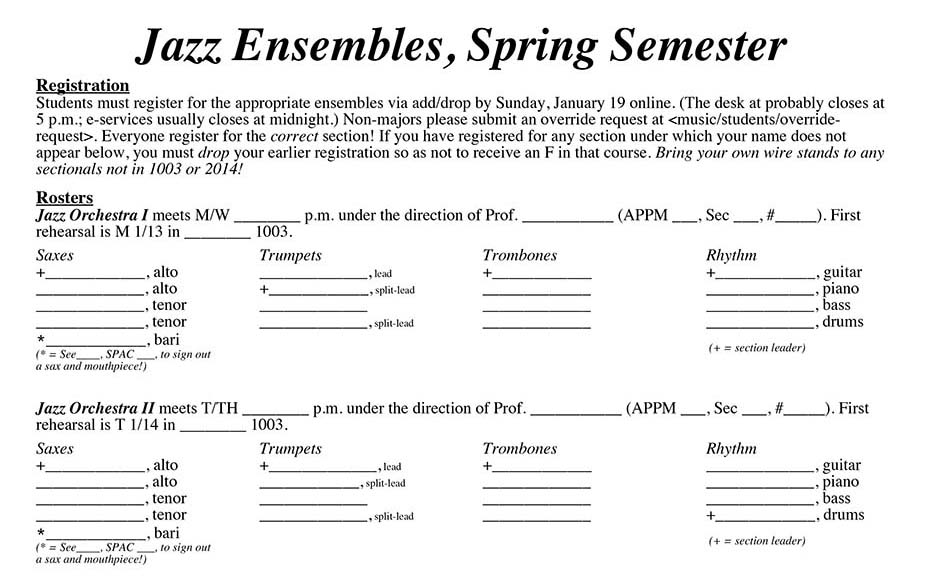 |
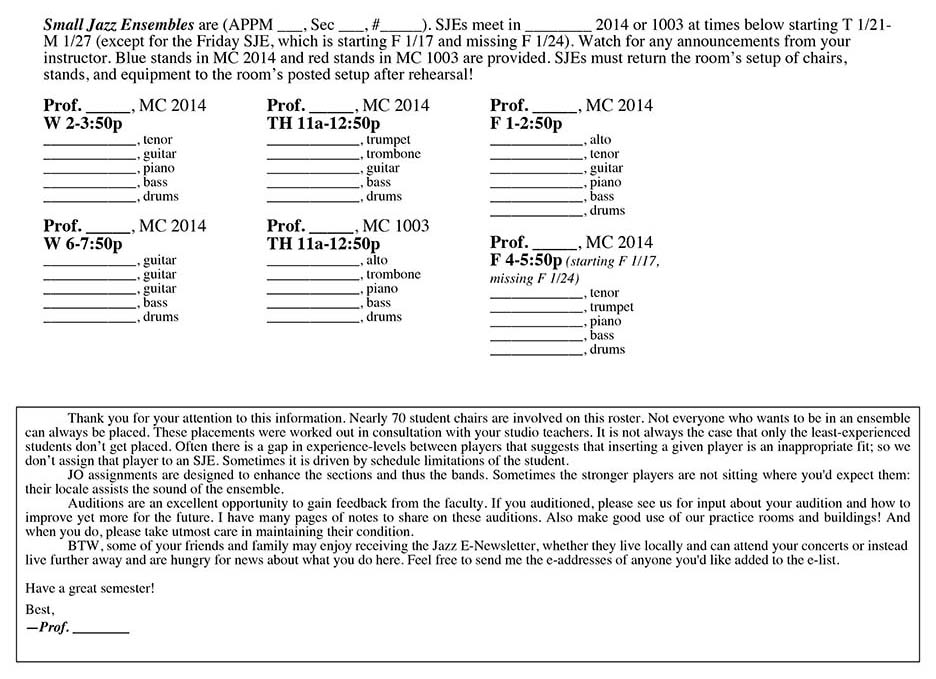 |
By carefully anticipating your students’ needs and your own within the audition process—yet annually noting adjustments to make for the future—you can create a system that allows you to gather critical information, focus on making your students as relaxed as possible, and efficiently place them into ensembles that will benefit both them and your musical community.
_ _ _ _ _ _ _ _ _ _ _ _ _ _ _
Antonio J. García is a Professor Emeritus and former Director of Jazz Studies at Virginia Commonwealth University, where he directed the Jazz Orchestra I; instructed Applied Jazz Trombone, Small Jazz Ensemble, Jazz Pedagogy, Music Industry, and various jazz courses; founded a B.A. Music Business Emphasis (for which he initially served as Coordinator); and directed the Greater Richmond High School Jazz Band. An alumnus of the Eastman School of Music and of Loyola University of the South, he has received commissions for jazz, symphonic, chamber, film, and solo works—instrumental and vocal—including grants from Meet The Composer, The Commission Project, The Thelonious Monk Institute, and regional arts councils. His music has aired internationally and has been performed by such artists as Sheila Jordan, Arturo Sandoval, Jim Pugh, Denis DiBlasio, James Moody, and Nick Brignola. Composition/arrangement honors include IAJE (jazz band), ASCAP (orchestral), and Billboard Magazine (pop songwriting). His works have been published by Kjos Music, Hal Leonard, Kendor Music, Doug Beach Music, ejazzlines, Walrus, UNC Jazz Press, Three-Two Music Publications, Potenza Music, and his own garciamusic.com, with five recorded on CDs by Rob Parton’s JazzTech Big Band (Sea Breeze and ROPA JAZZ). His scores for independent films have screened across the U.S. and in Italy, Macedonia, Uganda, Australia, Colombia, India, Germany, Brazil, Hong Kong, Mexico, Israel, Taiwan, and the United Kingdom. He has fundraised $5.5 million in external gift pledges for the VCU Jazz Program, with hundreds of thousands of dollars already in hand.
A Bach/Selmer trombone clinician, Mr. García serves as the jazz clinician for The Conn-Selmer Institute. He has freelanced as trombonist, bass trombonist, or pianist with over 70 nationally renowned artists, including Ella Fitzgerald, George Shearing, Mel Tormé, Doc Severinsen, Louie Bellson, Dave Brubeck, and Phil Collins—and has performed at the Montreux, Nice, North Sea, Pori (Finland), New Orleans, and Chicago Jazz Festivals. He has produced recordings or broadcasts of such artists as Wynton Marsalis, Jim Pugh, Dave Taylor, Susannah McCorkle, Sir Roland Hanna, and the JazzTech Big Band and is the bass trombonist on Phil Collins’ CD “A Hot Night in Paris” (Atlantic) and DVD “Phil Collins: Finally...The First Farewell Tour” (Warner Music). An avid scat-singer, he has performed vocally with jazz bands, jazz choirs, and computer-generated sounds. He is also a member of the National Academy of Recording Arts & Sciences (NARAS). A New Orleans native, he also performed there with such local artists as Pete Fountain, Ronnie Kole, Irma Thomas, and Al Hirt.
Mr. García is a Research Faculty member at The University of KwaZulu-Natal (Durban, South Africa) and the Associate Jazz Editor of the International Trombone Association Journal. He has served as a Network Expert (for Improvisation Materials), President’s Advisory Council member, and Editorial Advisory Board member for the Jazz Education Network . His newest book, Jazz Improvisation: Practical Approaches to Grading (Meredith Music), explores avenues for creating structures that correspond to course objectives. His book Cutting the Changes: Jazz Improvisation via Key Centers (Kjos Music) offers musicians of all ages the opportunity to improvise over standard tunes using just their major scales. He is Co-Editor and Contributing Author of Teaching Jazz: A Course of Study (published by NAfME), authored a chapter within Rehearsing The Jazz Band and The Jazzer’s Cookbook (published by Meredith Music), and contributed to Peter Erskine and Dave Black’s The Musician's Lifeline (Alfred). Within the International Association for Jazz Education he served as Editor of the Jazz Education Journal, President of IAJE-IL, International Co-Chair for Curriculum and for Vocal/Instrumental Integration, and Chicago Host Coordinator for the 1997 Conference. He served on the Illinois Coalition for Music Education coordinating committee, worked with the Illinois and Chicago Public Schools to develop standards for multi-cultural music education, and received a curricular grant from the Council for Basic Education. He has also served as Director of IMEA’s All-State Jazz Choir and Combo and of similar ensembles outside of Illinois. He is the only individual to have directed all three genres of Illinois All-State jazz ensembles—combo, vocal jazz choir, and big band—and is the recipient of the Illinois Music Educators Association’s 2001 Distinguished Service Award.
Regarding Jazz Improvisation: Practical Approaches to Grading, Darius Brubeck says, "How one grades turns out to be a contentious philosophical problem with a surprisingly wide spectrum of responses. García has produced a lucidly written, probing, analytical, and ultimately practical resource for professional jazz educators, replete with valuable ideas, advice, and copious references." Jamey Aebersold offers, "This book should be mandatory reading for all graduating music ed students." Janis Stockhouse states, "Groundbreaking. The comprehensive amount of material García has gathered from leaders in jazz education is impressive in itself. Plus, the veteran educator then presents his own synthesis of the material into a method of teaching and evaluating jazz improvisation that is fresh, practical, and inspiring!" And Dr. Ron McCurdy suggests, "This method will aid in the quality of teaching and learning of jazz improvisation worldwide."
About Cutting the Changes, saxophonist David Liebman states, “This book is perfect for the beginning to intermediate improviser who may be daunted by the multitude of chord changes found in most standard material. Here is a path through the technical chord-change jungle.” Says vocalist Sunny Wilkinson, “The concept is simple, the explanation detailed, the rewards immediate. It’s very singer-friendly.” Adds jazz-education legend Jamey Aebersold, “Tony’s wealth of jazz knowledge allows you to understand and apply his concepts without having to know a lot of theory and harmony. Cutting the Changes allows music educators to present jazz improvisation to many students who would normally be scared of trying.”
Of his jazz curricular work, Standard of Excellence states: “Antonio García has developed a series of Scope and Sequence of Instruction charts to provide a structure that will ensure academic integrity in jazz education.” Wynton Marsalis emphasizes: “Eight key categories meet the challenge of teaching what is historically an oral and aural tradition. All are important ingredients in the recipe.” The Chicago Tribune has highlighted García’s “splendid solos...virtuosity and musicianship...ingenious scoring...shrewd arrangements...exotic orchestral colors, witty riffs, and gloriously uninhibited splashes of dissonance...translucent textures and elegant voicing” and cited him as “a nationally noted jazz artist/educator...one of the most prominent young music educators in the country.” Down Beat has recognized his “knowing solo work on trombone” and “first-class writing of special interest.” The Jazz Report has written about the “talented trombonist,” and Cadence noted his “hauntingly lovely” composing as well as CD production “recommended without any qualifications whatsoever.” Phil Collins has said simply, “He can be in my band whenever he wants.” García is also the subject of an extensive interview within Bonanza: Insights and Wisdom from Professional Jazz Trombonists (Advance Music), profiled along with such artists as Bill Watrous, Mike Davis, Bill Reichenbach, Wayne Andre, John Fedchock, Conrad Herwig, Steve Turre, Jim Pugh, and Ed Neumeister.
The Secretary of the Board of The Midwest Clinic and a past Advisory Board member of the Brubeck Institute, Mr. García has adjudicated festivals and presented clinics in Canada, Europe, Australia, The Middle East, and South Africa, including creativity workshops for Motorola, Inc.’s international management executives. The partnership he created between VCU Jazz and the Centre for Jazz and Popular Music at the University of KwaZulu-Natal merited the 2013 VCU Community Engagement Award for Research. He has served as adjudicator for the International Trombone Association’s Frank Rosolino, Carl Fontana, and Rath Jazz Trombone Scholarship competitions and the Kai Winding Jazz Trombone Ensemble competition and has been asked to serve on Arts Midwest’s “Midwest Jazz Masters” panel and the Virginia Commission for the Arts “Artist Fellowship in Music Composition” panel. He was published within the inaugural edition of Jazz Education in Research and Practice and has been repeatedly published in Down Beat; JAZZed; Jazz Improv; Music, Inc.; The International Musician; The Instrumentalist; and the journals of NAfME, IAJE, ITA, American Orff-Schulwerk Association, Percussive Arts Society, Arts Midwest, Illinois Music Educators Association, and Illinois Association of School Boards. Previous to VCU, he served as Associate Professor and Coordinator of Combos at Northwestern University, where he taught jazz and integrated arts, was Jazz Coordinator for the National High School Music Institute, and for four years directed the Vocal Jazz Ensemble. Formerly the Coordinator of Jazz Studies at Northern Illinois University, he was selected by students and faculty there as the recipient of a 1992 “Excellence in Undergraduate Teaching” award and nominated as its candidate for 1992 CASE “U.S. Professor of the Year” (one of 434 nationwide). He is recipient of the VCU School of the Artsí 2015 Faculty Award of Excellence for his teaching, research, and service and in 2021 was inducted into the Conn-Selmer Institute Hall of Fame. Visit his web site at <www.garciamusic.com>.
If you entered this page via a
search engine and would like to visit more of this site,